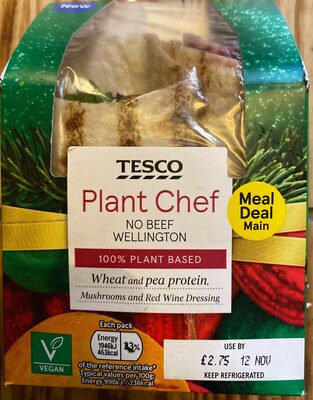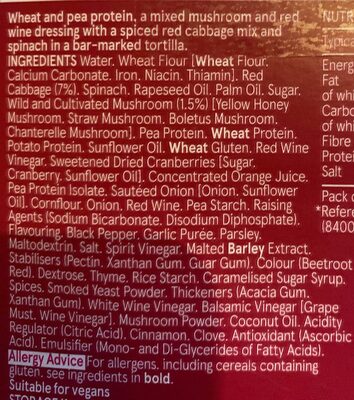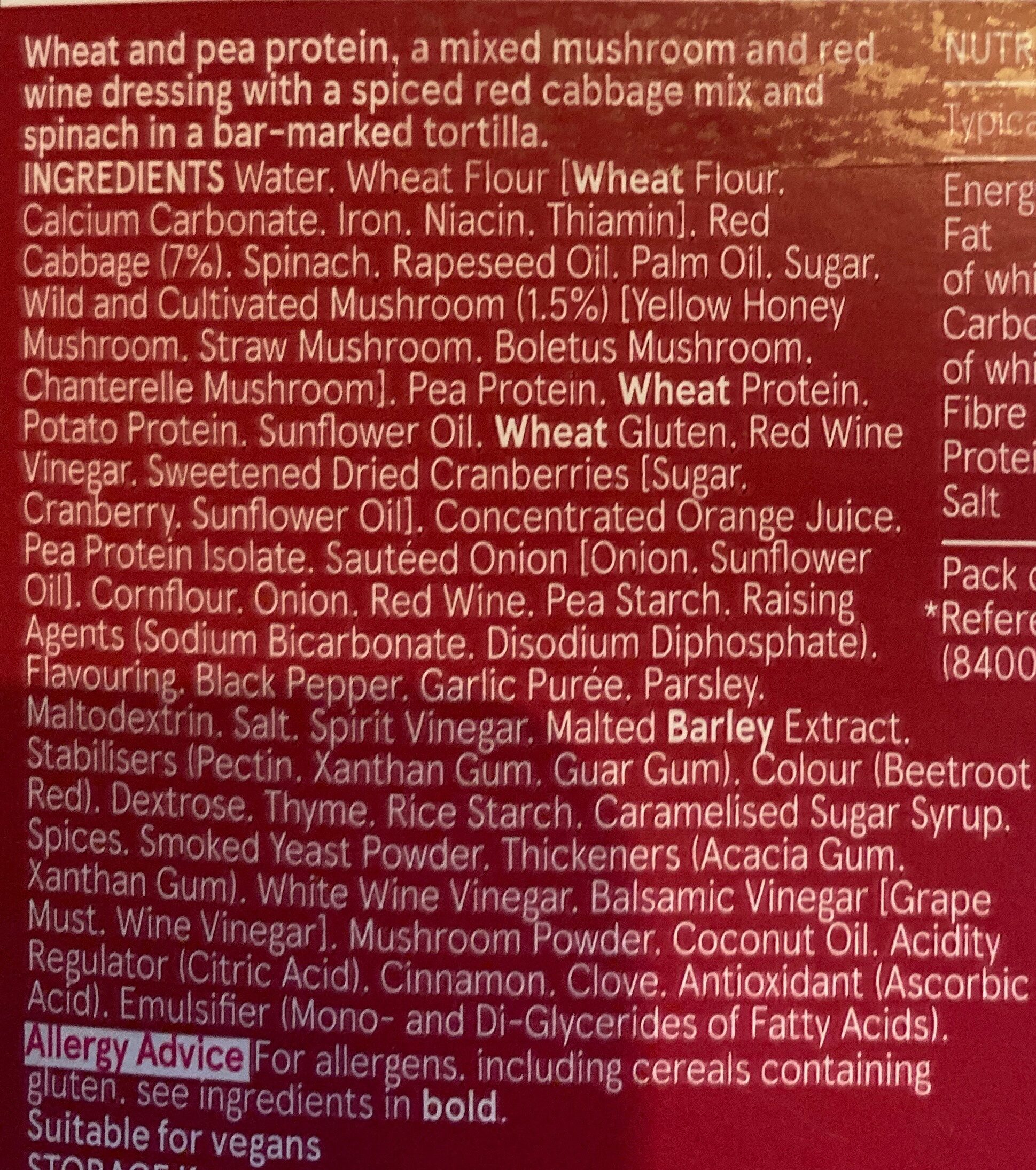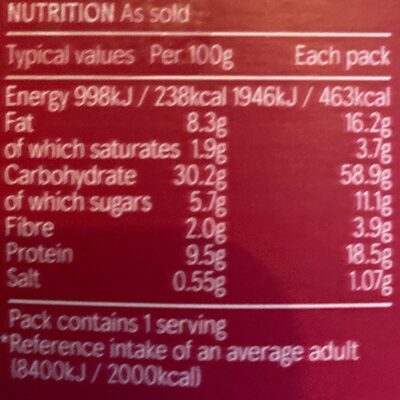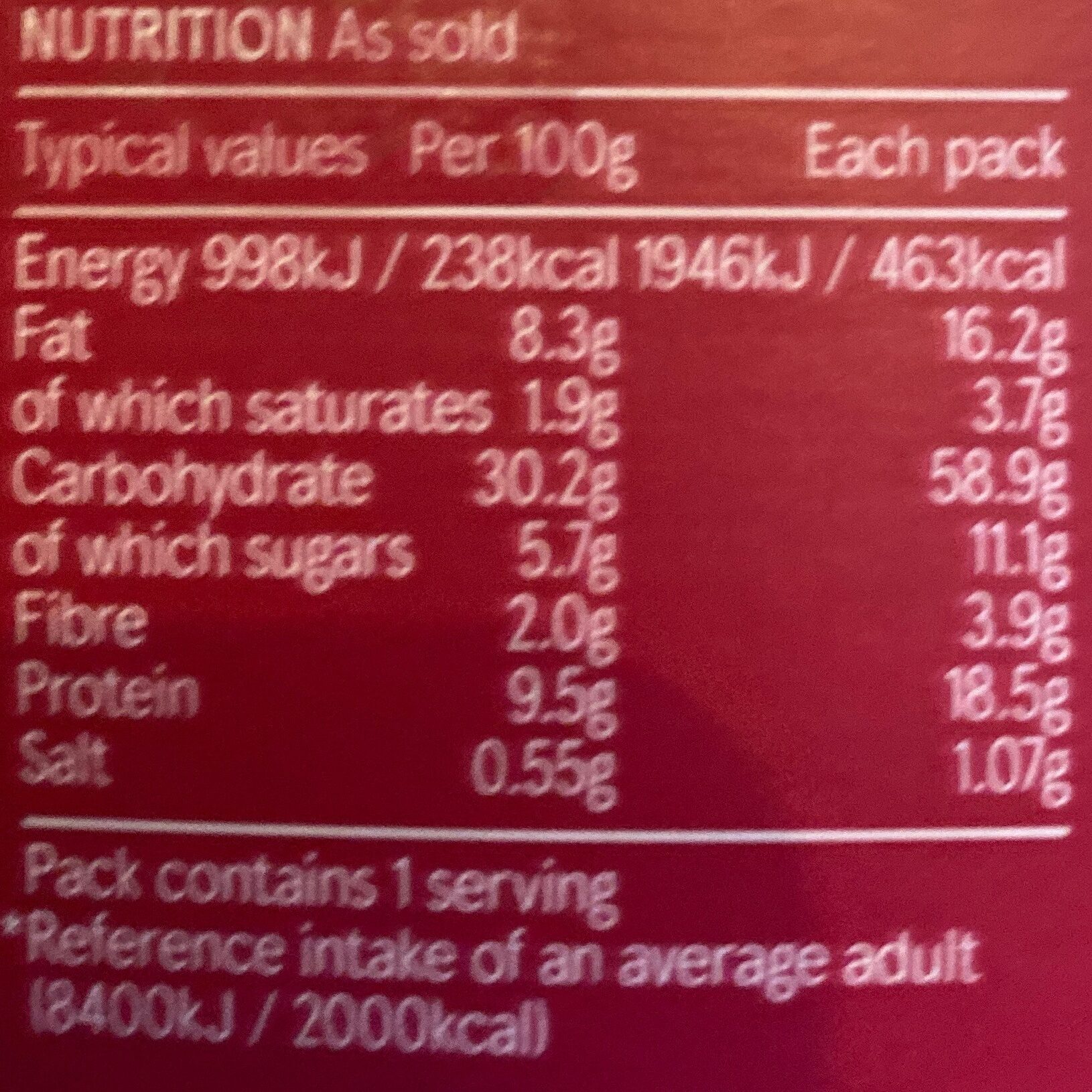Help us make food transparency the norm!
As a non-profit organization, we depend on your donations to continue informing consumers around the world about what they eat.
The food revolution starts with you!
Plant Chef No Beef Wellington Wrap - Tesco
Plant Chef No Beef Wellington Wrap - Tesco
Ambiguous barcode: This product has a Restricted Circulation Number barcode for products within a company. This means that different producers and stores can use the same barcode for different products.
×
This product page is not complete. You can help to complete it by editing it and adding more data from the photos we have, or by taking more photos using the app for Android or iPhone/iPad. Thank you!
×
Barcode: 03400968
Brands: Tesco
Categories: Meals, Sandwiches, Wraps
Labels, certifications, awards:
Vegetarian, Vegan, FSC, FSC Mix
Stores: Tesco
Countries where sold: United Kingdom
Matching with your preferences
Health
Ingredients
-
77 ingredients
Water. Wheat Flour [Wheat Flour. Calcium Carbonate. Iron. Niacin. Thiamin]. Red Cabbage (7%). Spinach. Rapeseed Oil. Palm Oil. Sugar. Wild and Cultivated Mushroom (1.5%) [Yellow Honey Mushroom. Straw Mushroom. Boletus Mushroom. Chanterelle Mushroom]. Pea Protein. Wheat Protein. Potato Protein. Sunflower Oil. Wheat Gluten. Red Wine Vinegar. Sweetened Dried Cranberries [Sugar. Cranberry. Sunflower Oil]. Concentrated Orange Juice. Pea Protein Isolate. Sautéed Onion [Onion. Sunflower Oil]. Cornflour. Onion. Red Wine. Pea Starch. Raising Agents (Sodium Bicarbonate. Disodium Diphosphate). Flavouring. Black Pepper. Garlic Purée. Parsley. Maltodextrin. Salt. Spirit Vinegar. Malted Barley Extract. Stabilisers (Pectin. Xanthan Gum, Guar Gum). Colour (Beetroot Red). Dextrose. Thyme. Rice Starch. Caramelised Sugar Syrup. Spices. Smoked Yeast Powder. Thickeners (Acacia Gum. Xanthan Gum). White Wine Vinegar. Balsamic Vinegar (Grape Must. Wine Vinegar]. Mushroom Powder. Coconut Oil. Acidity Regulator (Citric Acid). Cinnamon. Clove. Antioxidant (Ascorbic Acid). Emulsifier (Mono - and Di-Glycerides of Fatty Acids). Allergy Advice For allergens. including cereals containing gluten, see ingredients in bold.Allergens: Gluten
Food processing
-
Ultra processed foods
Elements that indicate the product is in the 4 - Ultra processed food and drink products group:
- Additive: E162 - Beetroot red
- Additive: E412 - Guar gum
- Additive: E414 - Acacia gum
- Additive: E415 - Xanthan gum
- Additive: E440 - Pectins
- Additive: E450 - Diphosphates
- Additive: E471 - Mono- and diglycerides of fatty acids
- Ingredient: Colour
- Ingredient: Dextrose
- Ingredient: Emulsifier
- Ingredient: Flavouring
- Ingredient: Glucose
- Ingredient: Gluten
- Ingredient: Maltodextrin
- Ingredient: Thickener
Food products are classified into 4 groups according to their degree of processing:
- Unprocessed or minimally processed foods
- Processed culinary ingredients
- Processed foods
- Ultra processed foods
The determination of the group is based on the category of the product and on the ingredients it contains.
Additives
-
E162 - Beetroot red
Betanin: Betanin, or Beetroot Red, is a red glycosidic food dye obtained from beets; its aglycone, obtained by hydrolyzing away the glucose molecule, is betanidin. As a food additive, its E number is E162. The color of betanin depends on pH; between four and five it is bright bluish-red, becoming blue-violet as the pH increases. Once the pH reaches alkaline levels betanin degrades by hydrolysis, resulting in a yellow-brown color. Betanin is a betalain pigment, together with isobetanin, probetanin, and neobetanin. Other pigments contained in beet are indicaxanthin and vulgaxanthins.Source: Wikipedia
-
E330 - Citric acid
Citric acid is a natural organic acid found in citrus fruits such as lemons, oranges, and limes.
It is widely used in the food industry as a flavor enhancer, acidulant, and preservative due to its tart and refreshing taste.
Citric acid is safe for consumption when used in moderation and is considered a generally recognized as safe (GRAS) food additive by regulatory agencies worldwide.
-
E412 - Guar gum
Guar gum (E412) is a natural food additive derived from guar beans.
This white, odorless powder is valued for its remarkable thickening and stabilizing properties, making it a common ingredient in various food products, including sauces, dressings, and ice creams.
When used in moderation, guar gum is considered safe for consumption, with no known adverse health effects.
-
E414 - Acacia gum
Gum arabic: Gum arabic, also known as acacia gum, arabic gum, gum acacia, acacia, Senegal gum and Indian gum, and by other names, is a natural gum consisting of the hardened sap of various species of the acacia tree. Originally, gum arabic was collected from Acacia nilotica which was called the "gum arabic tree"; in the present day, gum arabic is collected from acacia species, predominantly Acacia senegal and Vachellia -Acacia- seyal; the term "gum arabic" does not indicate a particular botanical source. In a few cases so‐called "gum arabic" may not even have been collected from Acacia species, but may originate from Combretum, Albizia or some other genus. Producers harvest the gum commercially from wild trees, mostly in Sudan -80%- and throughout the Sahel, from Senegal to Somalia—though it is historically cultivated in Arabia and West Asia. Gum arabic is a complex mixture of glycoproteins and polysaccharides. It is the original source of the sugars arabinose and ribose, both of which were first discovered and isolated from it, and are named after it. Gum arabic is soluble in water. It is edible, and used primarily in the food industry as a stabilizer, with EU E number E414. Gum arabic is a key ingredient in traditional lithography and is used in printing, paint production, glue, cosmetics and various industrial applications, including viscosity control in inks and in textile industries, though less expensive materials compete with it for many of these roles. While gum arabic is now produced throughout the African Sahel, it is still harvested and used in the Middle East.Source: Wikipedia
-
E415 - Xanthan gum
Xanthan gum (E415) is a natural polysaccharide derived from fermented sugars, often used in the food industry as a thickening and stabilizing agent.
This versatile food additive enhances texture and prevents ingredient separation in a wide range of products, including salad dressings, sauces, and gluten-free baked goods.
It is considered safe for consumption even at high intake amounts.
-
E440 - Pectins
Pectins (E440) are natural carbohydrates, predominantly found in fruits, that act as gelling agents in the food industry, creating the desirable jelly-like texture in jams, jellies, and marmalades.
Pectins stabilize and thicken various food products, such as desserts, confectioneries, and beverages, ensuring a uniform consistency and quality.
Recognized as safe by various health authorities, pectins have been widely used without notable adverse effects when consumed in typical dietary amounts.
-
E450 - Diphosphates
Diphosphates (E450) are food additives often utilized to modify the texture of products, acting as leavening agents in baking and preventing the coagulation of canned food.
These salts can stabilize whipped cream and are also found in powdered products to maintain their flow properties. They are commonly present in baked goods, processed meats, and soft drinks.
Derived from phosphoric acid, they're part of our daily phosphate intake, which often surpasses recommended levels due to the prevalence of phosphates in processed foods and drinks.
Excessive phosphate consumption is linked to health issues, such as impaired kidney function and weakened bone health. Though diphosphates are generally regarded as safe when consumed within established acceptable daily intakes, it's imperative to monitor overall phosphate consumption to maintain optimal health.
-
E471 - Mono- and diglycerides of fatty acids
Mono- and diglycerides of fatty acids (E471), are food additives commonly used as emulsifiers in various processed foods.
These compounds consist of glycerol molecules linked to one or two fatty acid chains, which help stabilize and blend water and oil-based ingredients. E471 enhances the texture and shelf life of products like margarine, baked goods, and ice cream, ensuring a smooth and consistent texture.
It is generally considered safe for consumption within established regulatory limits.
-
E500 - Sodium carbonates
Sodium carbonates (E500) are compounds commonly used in food preparation as leavening agents, helping baked goods rise by releasing carbon dioxide when they interact with acids.
Often found in baking soda, they regulate the pH of food, preventing it from becoming too acidic or too alkaline. In the culinary world, sodium carbonates can also enhance the texture and structure of foods, such as noodles, by modifying the gluten network.
Generally recognized as safe, sodium carbonates are non-toxic when consumed in typical amounts found in food.
-
E500ii - Sodium hydrogen carbonate
Sodium hydrogen carbonate, also known as E500ii, is a food additive commonly used as a leavening agent.
When added to recipes, it releases carbon dioxide gas upon exposure to heat or acids, causing dough to rise and resulting in a light, fluffy texture in baked goods.
It is generally recognized as safe (GRAS) by regulatory authorities when used in appropriate quantities and poses no significant health risks when consumed in typical food applications.
Ingredients analysis
-
Palm oil
Ingredients that contain palm oil: Palm oil
-
Vegan
No non-vegan ingredients
Unrecognized ingredients: Iron, Thiamin, Wild-and-cultivated-mushroom, Yellow-honey-mushroom, Boletus-mushroom, Chanterelle-mushroom, Sauteed-onionSome ingredients could not be recognized.
We need your help!
You can help us recognize more ingredients and better analyze the list of ingredients for this product and others:
- Edit this product page to correct spelling mistakes in the ingredients list, and/or to remove ingredients in other languages and sentences that are not related to the ingredients.
- Add new entries, synonyms or translations to our multilingual lists of ingredients, ingredient processing methods, and labels.
If you would like to help, join the #ingredients channel on our Slack discussion space and/or learn about ingredients analysis on our wiki. Thank you!
-
Vegetarian
No non-vegetarian ingredients detected
Unrecognized ingredients: Iron, Thiamin, Wild-and-cultivated-mushroom, Yellow-honey-mushroom, Boletus-mushroom, Chanterelle-mushroom, Sauteed-onionSome ingredients could not be recognized.
We need your help!
You can help us recognize more ingredients and better analyze the list of ingredients for this product and others:
- Edit this product page to correct spelling mistakes in the ingredients list, and/or to remove ingredients in other languages and sentences that are not related to the ingredients.
- Add new entries, synonyms or translations to our multilingual lists of ingredients, ingredient processing methods, and labels.
If you would like to help, join the #ingredients channel on our Slack discussion space and/or learn about ingredients analysis on our wiki. Thank you!
-
Details of the analysis of the ingredients
We need your help!
Some ingredients could not be recognized.
We need your help!
You can help us recognize more ingredients and better analyze the list of ingredients for this product and others:
- Edit this product page to correct spelling mistakes in the ingredients list, and/or to remove ingredients in other languages and sentences that are not related to the ingredients.
- Add new entries, synonyms or translations to our multilingual lists of ingredients, ingredient processing methods, and labels.
If you would like to help, join the #ingredients channel on our Slack discussion space and/or learn about ingredients analysis on our wiki. Thank you!
: Water, Wheat Flour (Wheat Flour, Calcium Carbonate, Iron, Niacin, Thiamin), Red Cabbage 7%, Spinach, Rapeseed Oil, Palm Oil, Sugar, Wild and Cultivated Mushroom 1.5% (Yellow Honey Mushroom, Straw Mushroom, Boletus Mushroom, Chanterelle Mushroom), Pea Protein, Wheat Protein, Potato Protein, Sunflower Oil, Wheat Gluten, Red Wine Vinegar, Cranberries (Sugar, Cranberry, Sunflower Oil), Concentrated Orange Juice, Pea Protein Isolate, Sautéed Onion (Onion, Sunflower Oil), Cornflour, Onion, Red Wine, Pea Starch, Raising Agents (Sodium Bicarbonate, Disodium Diphosphate), Flavouring, Black Pepper, Garlic Purée, Parsley, Maltodextrin, Salt, Spirit Vinegar, Malted Barley Extract, Stabilisers (Pectin, Xanthan Gum, Guar Gum), Colour (Beetroot Red), Dextrose, Thyme, Rice Starch, Caramelised Sugar Syrup, Spices, Yeast, Thickeners (Acacia Gum, Xanthan Gum), White Wine Vinegar, Balsamic Vinegar, Grape Must, Wine Vinegar, Mushroom Powder, Coconut Oil, Acidity Regulator (Citric Acid), Cinnamon, Clove, Antioxidant (Ascorbic Acid), Emulsifier (mono- and DiGlycerides of Fatty Acids), including cereals containing gluten- Water -> en:water - vegan: yes - vegetarian: yes - ciqual_food_code: 18066 - percent_min: 7 - percent_max: 78.5
- Wheat Flour -> en:wheat-flour - vegan: yes - vegetarian: yes - ciqual_proxy_food_code: 9410 - percent_min: 7 - percent_max: 42.75
- Wheat Flour -> en:wheat-flour - vegan: yes - vegetarian: yes - ciqual_proxy_food_code: 9410 - percent_min: 1.4 - percent_max: 42.75
- Calcium Carbonate -> en:e170i - vegan: maybe - vegetarian: maybe - percent_min: 0 - percent_max: 21.375
- Iron -> en:iron - percent_min: 0 - percent_max: 14.25
- Niacin -> en:e375 - vegan: maybe - vegetarian: maybe - percent_min: 0 - percent_max: 10.6875
- Thiamin -> en:thiamin - percent_min: 0 - percent_max: 8.55
- Red Cabbage -> en:red-cabbage - vegan: yes - vegetarian: yes - ciqual_food_code: 20014 - percent_min: 7 - percent: 7 - percent_max: 7
- Spinach -> en:spinach - vegan: yes - vegetarian: yes - ciqual_food_code: 20059 - percent_min: 1.5 - percent_max: 7
- Rapeseed Oil -> en:rapeseed-oil - vegan: yes - vegetarian: yes - from_palm_oil: no - percent_min: 1.5 - percent_max: 7
- Palm Oil -> en:palm-oil - vegan: yes - vegetarian: yes - from_palm_oil: yes - ciqual_food_code: 16129 - percent_min: 1.5 - percent_max: 7
- Sugar -> en:sugar - vegan: yes - vegetarian: yes - ciqual_proxy_food_code: 31016 - percent_min: 1.5 - percent_max: 5.7
- Wild and Cultivated Mushroom -> en:wild-and-cultivated-mushroom - percent_min: 1.5 - percent: 1.5 - percent_max: 1.5
- Yellow Honey Mushroom -> en:yellow-honey-mushroom - percent_min: 0.375 - percent_max: 1.5
- Straw Mushroom -> en:straw-mushroom - vegan: yes - vegetarian: yes - ciqual_food_code: 20010 - percent_min: 0 - percent_max: 0.75
- Boletus Mushroom -> en:boletus-mushroom - percent_min: 0 - percent_max: 0.5
- Chanterelle Mushroom -> en:chanterelle-mushroom - percent_min: 0 - percent_max: 0.375
- Pea Protein -> en:pea-protein - vegan: yes - vegetarian: yes - percent_min: 0 - percent_max: 1.5
- Wheat Protein -> en:wheat-protein - vegan: yes - vegetarian: yes - percent_min: 0 - percent_max: 1.5
- Potato Protein -> en:potato-protein - vegan: yes - vegetarian: yes - percent_min: 0 - percent_max: 1.5
- Sunflower Oil -> en:sunflower-oil - vegan: yes - vegetarian: yes - from_palm_oil: no - ciqual_food_code: 17440 - percent_min: 0 - percent_max: 1.5
- Wheat Gluten -> en:wheat-gluten - vegan: yes - vegetarian: yes - percent_min: 0 - percent_max: 1.5
- Red Wine Vinegar -> en:red-wine-vinegar - vegan: yes - vegetarian: yes - ciqual_food_code: 11018 - percent_min: 0 - percent_max: 1.5
- Cranberries -> en:cranberry - vegan: yes - vegetarian: yes - ciqual_food_code: 13113 - percent_min: 0 - percent_max: 1.5
- Sugar -> en:sugar - vegan: yes - vegetarian: yes - ciqual_proxy_food_code: 31016 - percent_min: 0 - percent_max: 1.5
- Cranberry -> en:cranberry - vegan: yes - vegetarian: yes - ciqual_food_code: 13113 - percent_min: 0 - percent_max: 0.75
- Sunflower Oil -> en:sunflower-oil - vegan: yes - vegetarian: yes - from_palm_oil: no - ciqual_food_code: 17440 - percent_min: 0 - percent_max: 0.5
- Concentrated Orange Juice -> en:concentrated-orange-juice - vegan: yes - vegetarian: yes - ciqual_proxy_food_code: 2070 - percent_min: 0 - percent_max: 1.5
- Pea Protein Isolate -> en:pea-protein-isolate - vegan: yes - vegetarian: yes - percent_min: 0 - percent_max: 1.5
- Sautéed Onion -> en:sauteed-onion - percent_min: 0 - percent_max: 1.5
- Onion -> en:onion - vegan: yes - vegetarian: yes - ciqual_food_code: 20034 - percent_min: 0 - percent_max: 1.5
- Sunflower Oil -> en:sunflower-oil - vegan: yes - vegetarian: yes - from_palm_oil: no - ciqual_food_code: 17440 - percent_min: 0 - percent_max: 0.75
- Cornflour -> en:corn-flour - vegan: yes - vegetarian: yes - ciqual_food_code: 9545 - percent_min: 0 - percent_max: 1.5
- Onion -> en:onion - vegan: yes - vegetarian: yes - ciqual_food_code: 20034 - percent_min: 0 - percent_max: 1.5
- Red Wine -> en:red-wine - vegan: maybe - vegetarian: yes - ciqual_food_code: 5214 - percent_min: 0 - percent_max: 1.5
- Pea Starch -> en:pea-starch - vegan: yes - vegetarian: yes - ciqual_proxy_food_code: 9510 - percent_min: 0 - percent_max: 1.5
- Raising Agents -> en:raising-agent - percent_min: 0 - percent_max: 1.5
- Sodium Bicarbonate -> en:e500ii - vegan: yes - vegetarian: yes - percent_min: 0 - percent_max: 1.5
- Disodium Diphosphate -> en:e450i - vegan: yes - vegetarian: yes - percent_min: 0 - percent_max: 0.75
- Flavouring -> en:flavouring - vegan: maybe - vegetarian: maybe - percent_min: 0 - percent_max: 1.5
- Black Pepper -> en:black-pepper - vegan: yes - vegetarian: yes - ciqual_food_code: 11015 - percent_min: 0 - percent_max: 1.5
- Garlic Purée -> en:garlic-puree - vegan: yes - vegetarian: yes - ciqual_food_code: 11000 - percent_min: 0 - percent_max: 1.5
- Parsley -> en:parsley - vegan: yes - vegetarian: yes - ciqual_proxy_food_code: 11014 - percent_min: 0 - percent_max: 1.5
- Maltodextrin -> en:maltodextrin - vegan: yes - vegetarian: yes - percent_min: 0 - percent_max: 1.5
- Salt -> en:salt - vegan: yes - vegetarian: yes - ciqual_food_code: 11058 - percent_min: 0 - percent_max: 0.55
- Spirit Vinegar -> en:spirit-vinegar - vegan: yes - vegetarian: yes - ciqual_food_code: 11018 - percent_min: 0 - percent_max: 0.55
- Malted Barley Extract -> en:barley-malt-extract - vegan: yes - vegetarian: yes - percent_min: 0 - percent_max: 0.55
- Stabilisers -> en:stabiliser - percent_min: 0 - percent_max: 0.55
- Pectin -> en:e440a - vegan: yes - vegetarian: yes - percent_min: 0 - percent_max: 0.55
- Xanthan Gum -> en:e415 - vegan: yes - vegetarian: yes - percent_min: 0 - percent_max: 0.275
- Guar Gum -> en:e412 - vegan: yes - vegetarian: yes - percent_min: 0 - percent_max: 0.183333333333333
- Colour -> en:colour - percent_min: 0 - percent_max: 0.55
- Beetroot Red -> en:e162 - vegan: yes - vegetarian: yes - percent_min: 0 - percent_max: 0.55
- Dextrose -> en:dextrose - vegan: yes - vegetarian: yes - ciqual_proxy_food_code: 31016 - percent_min: 0 - percent_max: 0.55
- Thyme -> en:thyme - vegan: yes - vegetarian: yes - ciqual_food_code: 11070 - percent_min: 0 - percent_max: 0.55
- Rice Starch -> en:rice-starch - vegan: yes - vegetarian: yes - ciqual_proxy_food_code: 9510 - percent_min: 0 - percent_max: 0.55
- Caramelised Sugar Syrup -> en:caramelised-sugar-syrup - vegan: yes - vegetarian: yes - ciqual_proxy_food_code: 31016 - percent_min: 0 - percent_max: 0.55
- Spices -> en:spice - vegan: yes - vegetarian: yes - percent_min: 0 - percent_max: 0.55
- Yeast -> en:yeast - vegan: yes - vegetarian: yes - percent_min: 0 - percent_max: 0.55
- Thickeners -> en:thickener - percent_min: 0 - percent_max: 0.55
- Acacia Gum -> en:e414 - vegan: yes - vegetarian: yes - percent_min: 0 - percent_max: 0.55
- Xanthan Gum -> en:e415 - vegan: yes - vegetarian: yes - percent_min: 0 - percent_max: 0.275
- White Wine Vinegar -> en:white-wine-vinegar - vegan: yes - vegetarian: yes - ciqual_food_code: 11018 - percent_min: 0 - percent_max: 0.55
- Balsamic Vinegar -> en:balsamic-vinegar - vegan: yes - vegetarian: yes - ciqual_food_code: 11091 - percent_min: 0 - percent_max: 0.55
- Grape Must -> en:grape-must - vegan: yes - vegetarian: yes - percent_min: 0 - percent_max: 0.55
- Wine Vinegar -> en:wine-vinegar - vegan: yes - vegetarian: yes - ciqual_food_code: 11018 - percent_min: 0 - percent_max: 0.55
- Mushroom Powder -> en:mushroom-powder - vegan: yes - vegetarian: yes - ciqual_food_code: 20010 - percent_min: 0 - percent_max: 0.55
- Coconut Oil -> en:coconut-oil - vegan: yes - vegetarian: yes - from_palm_oil: no - ciqual_food_code: 16040 - percent_min: 0 - percent_max: 0.55
- Acidity Regulator -> en:acidity-regulator - percent_min: 0 - percent_max: 0.55
- Citric Acid -> en:e330 - vegan: yes - vegetarian: yes - percent_min: 0 - percent_max: 0.55
- Cinnamon -> en:cinnamon - vegan: yes - vegetarian: yes - percent_min: 0 - percent_max: 0.55
- Clove -> en:clove - vegan: yes - vegetarian: yes - ciqual_food_code: 11052 - percent_min: 0 - percent_max: 0.55
- Antioxidant -> en:antioxidant - percent_min: 0 - percent_max: 0.55
- Ascorbic Acid -> en:e300 - vegan: yes - vegetarian: yes - percent_min: 0 - percent_max: 0.55
- Emulsifier -> en:emulsifier - percent_min: 0 - percent_max: 0.55
- mono- and DiGlycerides of Fatty Acids -> en:e471 - vegan: maybe - vegetarian: maybe - from_palm_oil: maybe - percent_min: 0 - percent_max: 0.55
- including cereals containing gluten -> en:cereals-containing-gluten - vegan: yes - vegetarian: yes - percent_min: 0 - percent_max: 0.55
Nutrition
-
Very good nutritional quality
⚠ ️Warning: the amount of fruits, vegetables and nuts is not specified on the label, it was estimated from the list of ingredients: 17This product is not considered a beverage for the calculation of the Nutri-Score.
Positive points: 7
- Proteins: 5 / 5 (value: 9.5, rounded value: 9.5)
- Fiber: 2 / 5 (value: 2, rounded value: 2)
- Fruits, vegetables, nuts, and colza/walnut/olive oils: 0 / 5 (value: 17.574145522248, rounded value: 17.6)
Negative points: 6
- Energy: 2 / 10 (value: 998, rounded value: 998)
- Sugars: 1 / 10 (value: 5.7, rounded value: 5.7)
- Saturated fat: 1 / 10 (value: 1.9, rounded value: 1.9)
- Sodium: 2 / 10 (value: 220, rounded value: 220)
The points for proteins are counted because the negative points are less than 11.
Nutritional score: (6 - 7)
Nutri-Score:
-
Nutrient levels
-
Fat in moderate quantity (8.3%)
What you need to know- A high consumption of fat, especially saturated fats, can raise cholesterol, which increases the risk of heart diseases.
Recommendation: Limit the consumption of fat and saturated fat- Choose products with lower fat and saturated fat content.
-
Saturated fat in moderate quantity (1.9%)
What you need to know- A high consumption of fat, especially saturated fats, can raise cholesterol, which increases the risk of heart diseases.
Recommendation: Limit the consumption of fat and saturated fat- Choose products with lower fat and saturated fat content.
-
Sugars in moderate quantity (5.7%)
What you need to know- A high consumption of sugar can cause weight gain and tooth decay. It also augments the risk of type 2 diabetes and cardio-vascular diseases.
Recommendation: Limit the consumption of sugar and sugary drinks- Sugary drinks (such as sodas, fruit beverages, and fruit juices and nectars) should be limited as much as possible (no more than 1 glass a day).
- Choose products with lower sugar content and reduce the consumption of products with added sugars.
-
Salt in moderate quantity (0.55%)
What you need to know- A high consumption of salt (or sodium) can cause raised blood pressure, which can increase the risk of heart disease and stroke.
- Many people who have high blood pressure do not know it, as there are often no symptoms.
- Most people consume too much salt (on average 9 to 12 grams per day), around twice the recommended maximum level of intake.
Recommendation: Limit the consumption of salt and salted food- Reduce the quantity of salt used when cooking, and don't salt again at the table.
- Limit the consumption of salty snacks and choose products with lower salt content.
-
-
Nutrition facts
Nutrition facts As sold
for 100 g / 100 mlCompared to: Wraps Energy 998 kj
(238 kcal)+2% Fat 8.3 g -5% Saturated fat 1.9 g -11% Carbohydrates 30.2 g +8% Sugars 5.7 g +109% Fiber 2 g -32% Proteins 9.5 g +7% Salt 0.55 g -48% Fruits‚ vegetables‚ nuts and rapeseed‚ walnut and olive oils (estimate from ingredients list analysis) 17.574 %
Environment
-
Eco-Score not computed - Unknown environmental impact
We could not compute the Eco-Score of this product as it is missing some data, could you help complete it?Could you add a precise product category so that we can compute the Eco-Score? Add a category
Packaging
-
Missing packaging information for this product
⚠ ️ The information about the packaging of this product is not filled in.Take a photo of the recycling information Take a photo of the recycling information
Transportation
-
Origins of ingredients
Missing origins of ingredients information
⚠ ️ The origins of the ingredients of this product are not indicated.
If they are indicated on the packaging, you can modify the product sheet and add them.
If you are the manufacturer of this product, you can send us the information with our free platform for producers.Add the origins of ingredients for this product Add the origins of ingredients for this product
Threatened species
-
Contains palm oil
Drives deforestation and threatens species such as the orangutan
Tropical forests in Asia, Africa and Latin America are destroyed to create and expand oil palm tree plantations. The deforestation contributes to climate change, and it endangers species such as the orangutan, the pigmy elephant and the Sumatran rhino.
Report a problem
-
Incomplete or incorrect information?
Category, labels, ingredients, allergens, nutritional information, photos etc.
If the information does not match the information on the packaging, please complete or correct it. Open Food Facts is a collaborative database, and every contribution is useful for all.
Data sources
Product added on by kiliweb
Last edit of product page on by roboto-app.
Product page also edited by baileysloan, raturibot, yuka.sY2b0xO6T85zoF3NwEKvlkAfVYSA-27OMQTkk0OT-c2rC7-zbN5_3an7Y6s.
